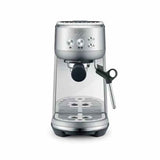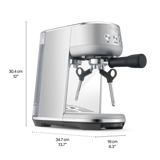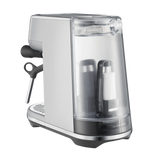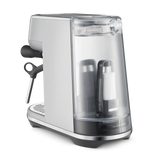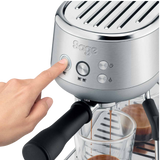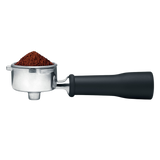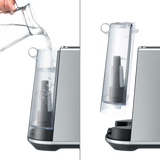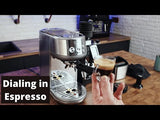The Bambino is a different breed of machine from the lower priced popular espresso machines such as the DeLonghi Dedica, and very similarly priced machines too such as the Smeg ECF01.
Features and Benefits
• 1.4 L Water Tank
• 3 Second Ready Time
• Low Pressure Preinfusion
• PID Temperature Control
• 9 Bar Espresso Extraction
• Standard + Pressurized Baskets
• Hot Water Button
• Tiny Footprint of 19cm wide & 30.4cm deep, 31 cm height
Most lower cost espresso machines have a number of things in common:
• Pressurized baskets or pressurized portafilters
• High espresso pressure
• Unstable brew temperature
• No preinfusion
• Panarello steam wand
If you’re spending a few hundred quid more, you’d usually expect the machine to tick at least some of these off the list, although it’s fair to say that even some of the £500+ espresso machines have at least one or two of the above quirks.
The Best Cheap Espresso Machines
The Bambino is the lowest-priced espresso machine I’m aware of that none of the above applies to!
Traditional Baskets
If you want to be able to dial in, in order to get the best-tasting espresso possible, this is done with traditional baskets, not the pressurised baskets that most cheaper machines come with.
It does come with pressurised baskets for anyone who wants to use pre-ground coffee or supermarket coffee beans, but it also comes with standard/traditional baskets for using freshly ground, freshly roasted beans.
9 Bars of Pressure
It has an OPV (overpressure valve) set to 9 bars, the ideal pressure for espresso.
Yes, it has a vibration pump, these are usually 15 bar pumps which is why you’ll see so many brands boasting “15 bars of pressure”, but this really isn’t a boast.
What is a boast for the bambino is being one of the very few machines at this kind of cost that is limited to the professional espresso pressure of 9 bars.
Temperature Stability
You can have an espresso machine with as many bells and whistles as you like, if it’s not temperature stable you’ll struggle with espresso consistency shot to shot.
The Bambino, and all of Sage’s other espresso machines, have a PID (proportional integral derivative) an electronic temperature controller.
This is something that puts this little inexpensive machine ahead of many espresso machines costing up to double or even triple the price where temperature stability is concerned.
Cheaper espresso machines are notorious for temperature swings, leading to users of such machines having to adopt a specific workflow to incorporate what is known as temperature surfing.
In fact, there are machines that are quite a bit more expensive than the bambino (Gaggia Classic, Rancilio Silvia) which are better than the Bambino in certain areas (durability, longevity, serviceability) but which require the fitting of an aftermarket PID (£100-£150) just to bring them up to scratch with the Bambino where temperature stability is concerned.
Pre-Infusion
Preinfusion is what I usually refer to as (because I’m a Dad, so I have a license to make unlimited Dad jokes) “wetting the bed”, and it’s when the ground coffee in the basket is introduced to water under low pressure first before the pressure is ramped up to the full 9 bars.
This is mainly done to prevent channelling, where water under high pressure finds less restricted flow channels through the puck of coffee, which leads to a deterioration in taste.
Traditional preinfusion would usually be delivered at line pressure, so it’s common to find people stating that any tank-fed machines claiming to offer pre-infusion don’t technically do this, but with the Sage machines, it really is low-pressure preinfusion.
Some tank-fed machines deal with preinfusion by simply pulsing the pump on and off, at full pressure, this isn’t what Sage machines do. The pump is actually controlled in order to delivery low-pressure preinfusion.
Each shot is started with a factory pre-set 8 second pre-infusion, and you can’t tweak this on the Bambino however you can control it manually by pressing and holding either shot button for as long as you want pre-infusion to last, in case you want to try preinfusion for a second or two longer, or shorter.
Pro Steam Wand
Most lower-cost espresso machines have what’s referred to as a panarello steam wand, a sheath on the steam pipe with an air intake to draw air into the milk as it’s being steamed to heat it.
These are mega easy to use, and they’re fine if you’re not that fussed about your milk texture. They have a tendency to create bigger bubbled, stiffer foam for the kind of cappuccino & latte those of us over 40 will remember being the only option when we were growing up.
Pro steam wands instead of having a sheath over the wand and a hole on the side, have a longer pipe with a tip on the end with one or multiple holes, designed to give the barista total control over the level of aeration and therefore complete control over milk texture.
So if you’re wanting to produce great quality microfoam for flat whites, cortado, and for more modern third wave cappuccino or latte, then you’ll want to master the use of pro steam wands.
The great thing with the Sage machines is that their steam wands are among the easiest and most forgiving to learn with.
For my full review on the Bambino and also the Bambino Plus (I cover them both in one review, with comparisons) see:








